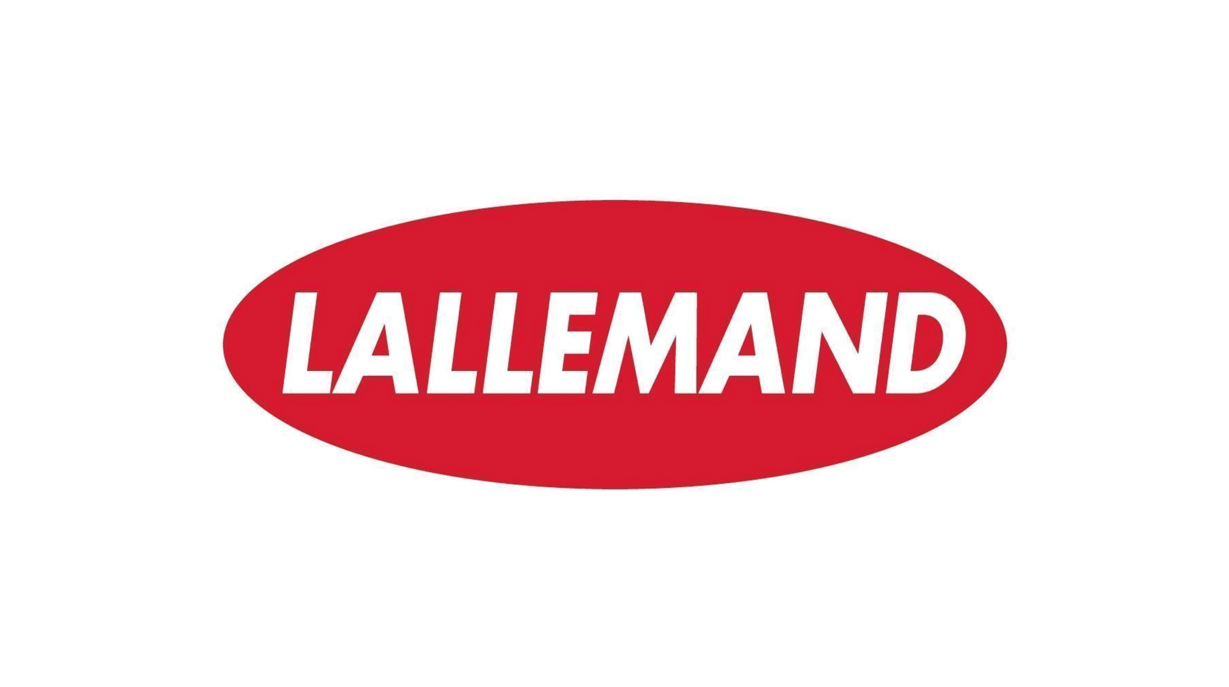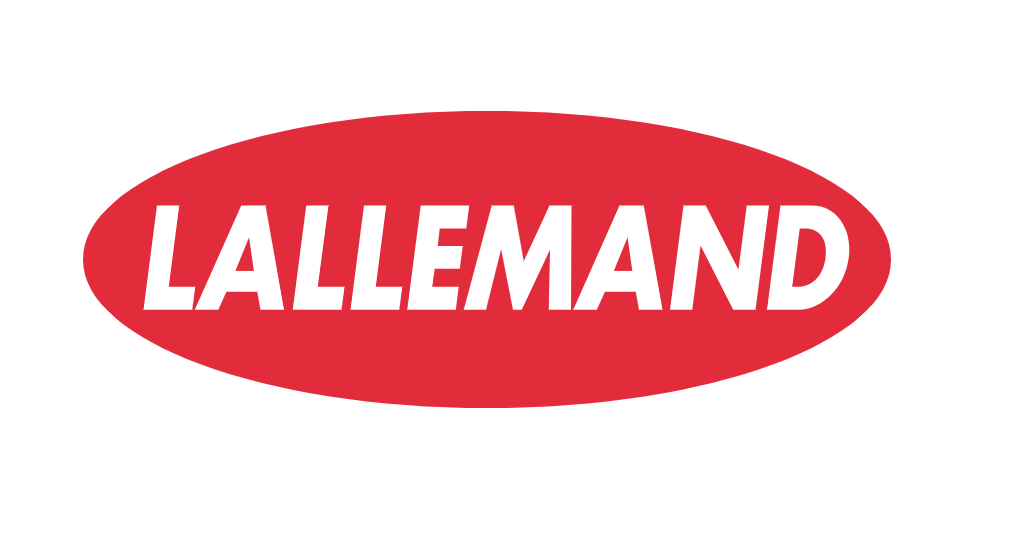



Managing dairy calf nutrition: cooperating with the microbiome from calf milk replacer to weaning transition
Specific non-dairy ingredients such as yeast could be valuable for neonatal calf diets when properly incorporated into calf milk replacers.Milk proteins are commonly used as protein ingredient sources for calf milk replacer formulations. However, these dairy-origin ingredients are increasingly less economical for use in animal feed due to increased human global demand for high-quality dairy ingredients. As an alternative, specific non-dairy ingredients such as yeast could be valuable for neonatal calf diets when properly incorporated into calf milk replacers.
Calf morbidity is a great concern in modern dairy farming, with the first two months of the calf’s life crucial for future productive life. The digestive tract of young ruminants undergoes extensive changes during the transition from liquid to solid feed. In the longer term, if the management of dairy heifer calves is suboptimal, their performance as adult lactating cows can be reduced. Numerous independent peer-reviewed research studies show a clear link between post-birth live-weight gains and future performance up to the third lactation (Windeyer et al., 2014). Such early adaptations to a nutritional stress/stimulus permanently change the physiology and metabolism of the organism and continue to be expressed even in the absence of the stimulus/stress that initiated them (Patel and Srinivansan, 2002).
Protein is a crucial nutrient in milk replacers (MR), and selecting appropriate protein sources is essential for optimising animal health, performance, and production costs. Due to the rising cost of milk protein and the increasing human consumption of whey proteins (Thornsberry et al., 2016), research has shifted towards alternative protein sources. Considering the use of milk replacers, as the calf transition from pre-ruminant to ruminant (post-weaning), among other factors, the following factors can be considered: weaning strategies, rate of milk replacer feeding, interaction of milk and starter diets, milk replacer composition and benefits of potential non-dairy sustainable alternative ingredients to include in milk replacers.

Hydrolysed yeast as an alternative protein source in milk replacers
Due to the rising cost of milk protein and the increasing human consumption of whey proteins (Thornsberry et al., 2016), research is shifting towards alternative protein sources in milk replacers. High-quality hydrolysed yeast (YELA PROSECURE) is one of the proven alternatives.
Effects on growth performance and farm profitability
In a recent study conducted by Lallemand Animal Nutrition and Institut de l’Elevage, France, the partial (3%) replacement of skimmed milk powder in the milk replacer formula of calves by a hydrolysed yeast (YELA PROSECURE) showed better performance outcomes (Figure 2) without compromising animal health and carcass quality, and giving opportunities for milk replacer formulation. The net farm profit for incorporating hydrolysed yeast was €38.86 per animal.
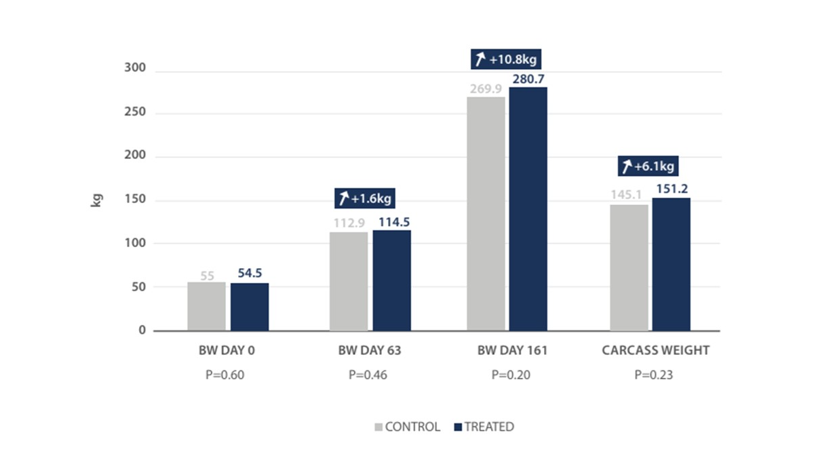
Importance of weaning strategies on post-weaning performance
Steele et al. in 2017 investigated feed intake, growth, and bio-markers of gastrointestinal development in calves fed an elevated plane of nutrition that were either weaned abruptly (0 d step-down) or using a gradual weaning strategy (12 d step-down initiated at d 36 with a 50% reduction of milk until d 48) before complete milk replacer withdrawal at 48 d of life. In this study, faecal starch was considered an effective marker of starch digestibility. High faecal starch may reflect an increased passage rate of feed material from the rumen, or impaired ruminal digestion and lower gut function (through gut permeability as reported by Wood et al., 2015), corresponding to depressed growth and health evident during abrupt weaning. The impaired function and permeability of the lower gut may result in the drawing of additional energy to mount an inflammatory response at the expense of growth.

The rate of milk replacer feeding on calf performance
In the study by van Niekerk et al. (2020), researchers evaluated the effects of milk replacer (MR) feeding rate and processing of corn in calf starter diet on growth performance, nutrient digestibility, and rumen and faecal fibrolytic bacteria in dairy calves. Overall, the results showed that the rate of MR feeding has a larger effect than the processing of corn in calf starter diets (Figure 4) on performance, fibre digestibility, and rumen and faecal fibrolytic bacterial communities.
- Factor 1 – High (HI) and Low (LO) Milk: (0.749 kg of MR/d (LO) and 1.498 kg of MR/d (HI)
- Factor 2 – Whole (W) and Flaked (F) corn in calf starter
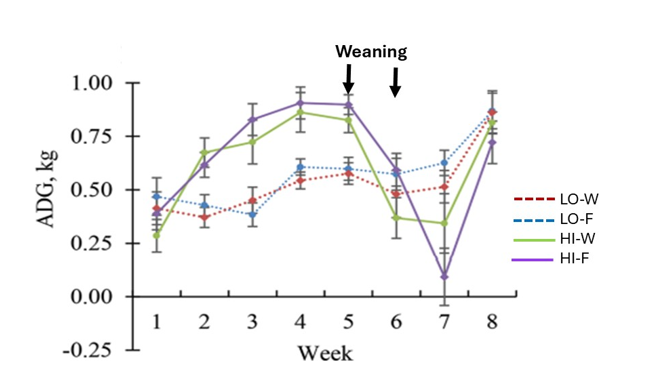
In a similar study (Yohe et al., 2021), on the interaction between milk replacer and starter diet (low or high starch), results (Figure 4) showed that the rate of MR feeding has a larger effect than the level of starch in the starter diet.
Partial replacements of lactose with fat in milk replacers
Studies show that most milk replacers contain more lactose compared with whole milk, which, when fed at a large meal size, could influence gut barrier function in calves. In a study by Welboren et al. (2021), the partial replacement of lactose in MR with fat resulted in higher weight gain per unit of metabolizable energy (ME) intake, reflecting higher energy retention (Figure 5).
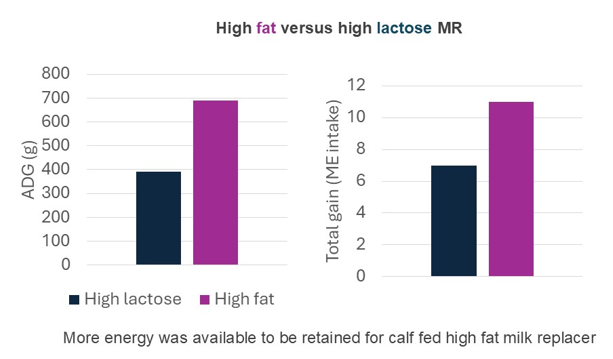
How milk replacers can induce gut permeability
When formulating milk replacer diets, osmolality (expressed in mOsm/kg) is important (Figure 6); osmolarity depends on the presence of osmotically active particles dissolved in solution, including electrolytes, oligo- and monosaccharides, amino acids, and fatty acids (Pearson et al., 2013 in Wilms et al., 2019). Commercial calf milk replacers often contain higher levels of minerals (ash fraction) and lactose than cow raw milk. Consequently, the osmolality of milk replacers can range from slightly hypertonic (just above 300 mOsm/kg) to highly hypertonic (>450 mOsm/kg).
Recent studies (Wilms et al., 2019; Welboren et al., 2021) have shown that hypertonic milk replacers increase gut permeability by compromising the GIT barrier function. On the other hand, high lactose MRs alter insulin sensitivity. Therefore, hypertonicity of milk replacers can be considered a potential risk factor for calf health. Studies show that, by decreasing gut permeability, the incidence of diarrhoea in dairy calves in the pre-weaned stage decreases.
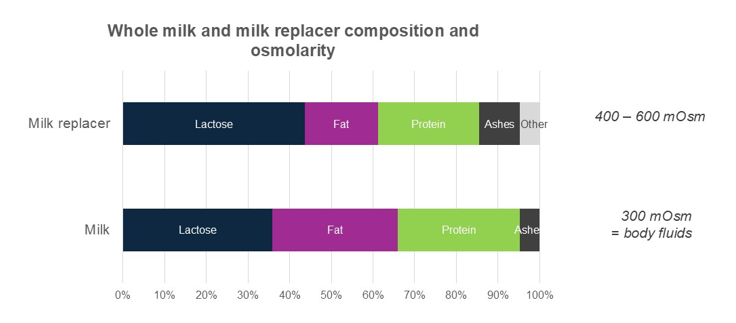
How to mitigate this gut permeability and inflammation negative effects?
Colonisation and development of the gut microbiome are crucial for the growth and health of calves. Disruption of the gut microbiome leads to digestive diseases in calves, such as diarrhoea and intestinal inflammation. The colonisation of microbiota in the gut of calves continues to change as influenced by various factors such as age, diet, genotype and nutritional supplements such as yeasts, among others. The abundance and diversity of commensal microbiota is supporting gut function and integrity and play a crucial role in the health of calves.
How yeast fractions improve gut health and microbiota balance
In a recent study (Gauthier et al., 2025) conducted by Lallemand Animal Nutrition and the University of Lublin, Poland, a feed ingredient including multi strain yeast fractions of Saccharomyces cerevisiae and Cyberlindnera jadinii (YANG) was found to help maintain the health of pre-ruminants by reinforcing immunity and improving the gut integrity and microbiota balance while enhancing calf growth performance and farm profitability. These positive effects can be due to enhanced natural defenses, reduction gut permeability effects and inflammation that costs calves a lot of energy to cope with.
In addition to increased mucus production that will protect the intestinal barrer, the yeast fraction-supplemented (YANG at 800 g/ton in milk replacer from day 5 to 65) calves showed better promotion of positive bacteria populations, such as:
- More Akkermansia, which stimulates host mucin production and regulates anti-inflammatory cytokines (Furman et al., 2020).
- More Bifidobacteria that compete with pathogenic bacteria, reduce the incidence of diarrhoea and increase weight gain (Abd El-Tawad et al., 2016)
- Less Fusobacterium, a potential pathogen for the liver of ruminants (Tadepalli et al., 2009).
- More Succiniclasticum that are propionate producers, linked with gut maturation (Dias et al., 2017).
Enhancing growth performance and farm profitability
The yeast fraction supplement significantly improved the average daily gain (Figure 7) of calves during the first 30 days (+46g/d), with a numerical improvement of final BW at 60 days (+1.6kg) and a tendency for better overall FCR. The calves supplemented with yeast fractions of Saccharomyces cerevisiae and Cyberlindnera jadinii showed lower morbidity and mortality, both at digestive and respiratory levels, with a consequent decrease in the number of therapeutic treatments and costs. Positive effects on intestinal health and growth, and the reduction of antibiotic treatments, support farm profitability and sustainability (Figure 6).

Concluding remarks
- The early development of immunity and microbiota in the gut of newborn calves can have lifelong consequences.
- The changes in the gut microbiome, along with nutritional and immune functions, are crucial for the health and development of calves. Understanding the factors that affect gut development helps to optimise the health and production efficiency of ruminants.
- Multiple strategies can be used to optimize calf digestive health when formulating milk replacer such a lactose and fat balance, osmolarity of the mix and level of milk replacer and starter for the weaning transition. Using specific ingredient to support this challenge can help improves post-weaning performance.
- Incorporating hydrolysed yeast in calf milk replacer at the beginning of the rearing phase can effectively substitute a high-quality milk protein source, achieving similar performance outcomes without compromising calf performance, health and carcass quality.
- Supplementation with yeast fractions of Saccharomyces cerevisiae and Cyberlindnera jadinii reduces calf morbidity and mortality, with positive effects on intestinal health and growth, supporting farm profitability and sustainability.
- Specific non-dairy ingredients, such as yeast products, can be valuable supplements in calf diets when properly incorporated into calf milk replacers.

